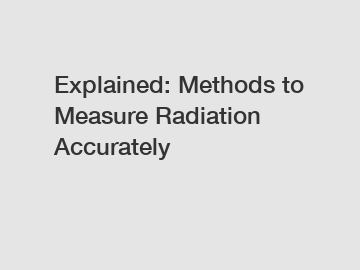Jan. 27, 2024
Machinery
Nuclear & Electronics Product Page
Radiation is an invisible force that surrounds us, emanating from various natural and man-made sources. With significant advancements in technology and increased understanding of its effects, accurately measuring radiation has become crucial in today's world. In this blog, we will delve into the various methods used to measure radiation accurately, shedding light on the tools and techniques employed by experts in this field.
1. Geiger-Muller Counters:

Geiger-Muller (GM) counters are one of the most commonly used tools to measure radiation. These handheld devices detect ionizing radiation, such as alpha and beta particles, as well as gamma rays. The GM counter operates by using a gas-filled tube that, when hit by radiation, causes the ionization of gas atoms, leading to electrical pulses that are then counted and displayed. These counters provide rapid and portable measurements, making them ideal for emergency responders and nuclear facilities.
2. Scintillation Detectors:
Scintillation detectors are another widely used method to measure radiation accurately. These detectors utilize materials called scintillators, which produce flashes of light when radiation interacts with them. The emitted light is then detected by a photomultiplier tube, which converts it into an electrical signal for analysis. Scintillation detectors are highly sensitive and capable of differentiating between types and energies of radiation, making them valuable tools in medical imaging and nuclear research.
3. Ionization Chambers:
Ionization chambers are used when precise measurement of radiation doses is required. These chambers consist of an insulated cylindrical tube containing a gas or air that, when exposed to radiation, generates a measurable electrical charge. This charge is collected and measured, providing a quantifiable measurement of the radiation absorbed. Ionization chambers are commonly used in medical applications, such as radiation therapy and diagnostic imaging.
4. TLD (Thermoluminescent Dosimeters):
TLDs are small devices made of crystalline materials that emit light when exposed to radiation. These dosimeters can record radiation exposure for extended periods. When a TLD is exposed to radiation, the energy absorbed is stored within the crystal structure. By heating the TLD, this stored energy is released as light, which can then be measured to determine the amount of radiation received. TLDs are often used in occupational monitoring and personal dosimetry.
5. Film Badge Dosimetry:
Film badge dosimetry is an older, yet still effective, method used to measure radiation exposure. It involves wearing a small film badge that contains photographic film sensitive to radiation. When exposed, the film undergoes changes in density, providing an indication of the received dose. Film badge dosimetry is commonly used for personnel working with radiation sources in industries such as nuclear power plants and radiography.
6. Remote Sensing:
Advancements in remote sensing have expanded our ability to measure radiation accurately over larger areas. Satellites equipped with sophisticated sensors can detect and quantify radiation levels from space. These measurements are especially valuable in monitoring nuclear meltdowns, identifying radiation hotspots, and understanding long-term effects on ecosystems. Remote sensing allows for continuous and broad-scale monitoring of radiation, providing invaluable data for environmental assessments.
Conclusion:
Accurate measurement of radiation is essential in various fields, including healthcare, nuclear energy, and environmental monitoring. The methods mentioned above, including Geiger-Muller counters, scintillation detectors, ionization chambers, TLDs, film badge dosimetry, and remote sensing, all play crucial roles in ensuring precise measurements. By utilizing these tools and techniques, experts can increase our understanding of radiation's impact and enable informed decision-making to protect human health and the environment. With ongoing advancements, measuring radiation accurately will continue to improve, enabling proactive steps toward managing potential risks associated with this invisible yet powerful force.
If you are looking for more details, kindly visit our website.
Are you interested in learning more about radiation protection solutions? Contact us today to secure an expert consultation!
Previous: What is the problem with fiber laser cutting?
Next: What are the advantages of automated PCB AOI inspection for B2B purchasers?
If you are interested in sending in a Guest Blogger Submission,welcome to write for us!
All Comments ( 0 )